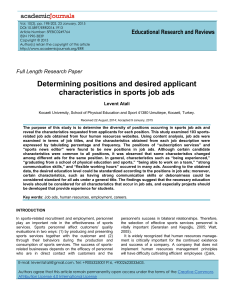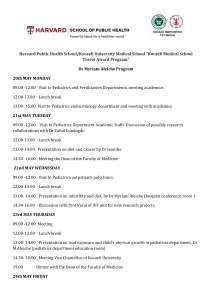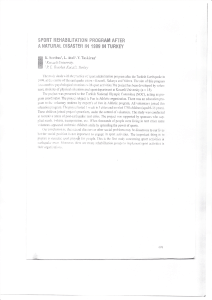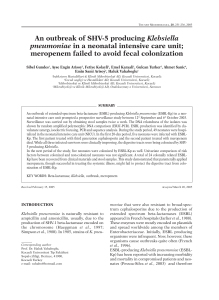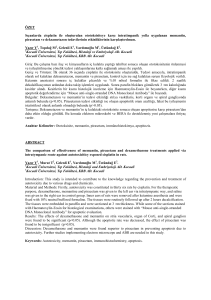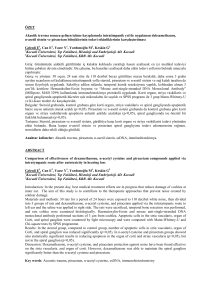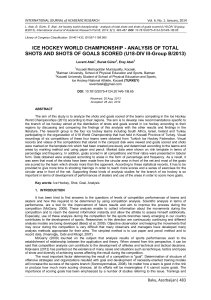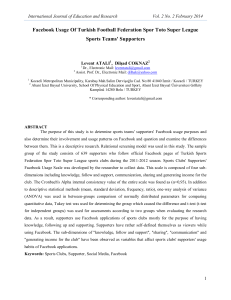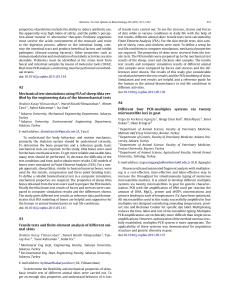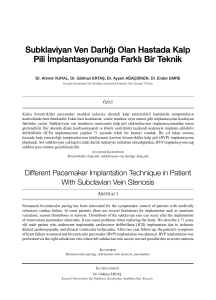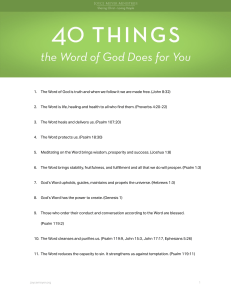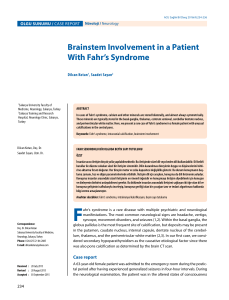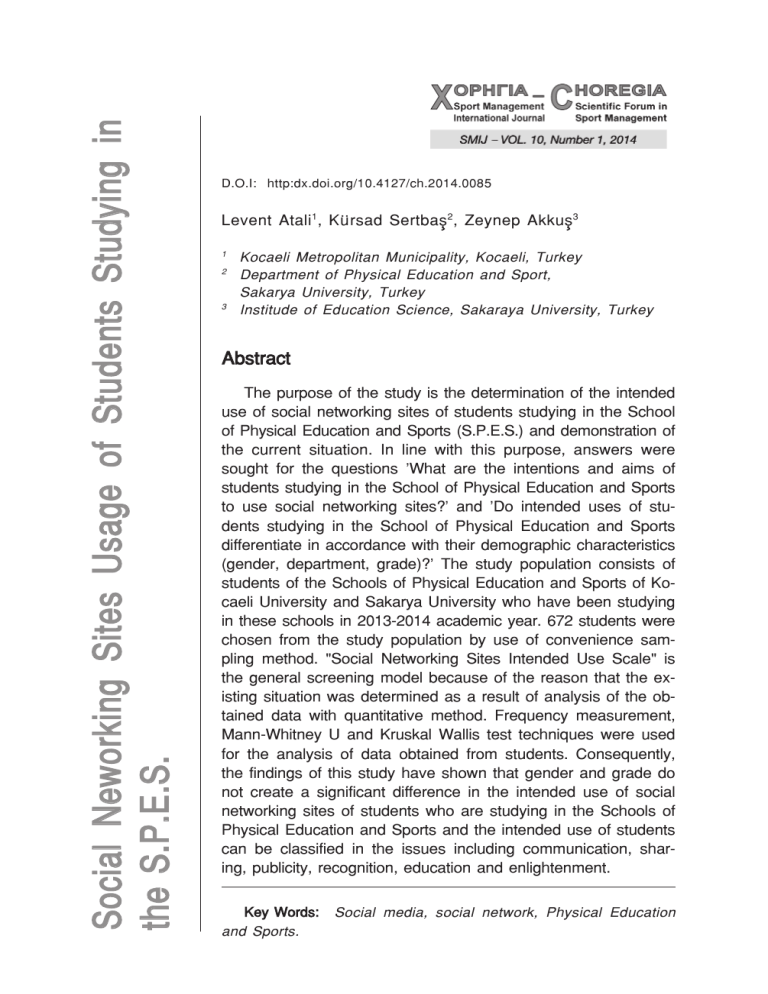
Social Neworking Sites Usage of Students Studying in
the S.P.E.S.
D.O.I: http:dx.doi.org/10.4127/ch.2014.0085
..
Levent Atali1, Ku rsad Sertbas2, Zeynep Akkus3
1
2
3
Kocaeli Metropolitan Municipality, Kocaeli, Turkey
Department of Physical Education and Sport,
Sakarya University, Turkey
Institude of Education Science, Sakaraya University, Turkey
Abstract
The purpose of the study is the determination of the intended
use of social networking sites of students studying in the School
of Physical Education and Sports (S.P.E.S.) and demonstration of
the current situation. In line with this purpose, answers were
sought for the questions 'What are the intentions and aims of
students studying in the School of Physical Education and Sports
to use social networking sites?' and 'Do intended uses of students studying in the School of Physical Education and Sports
differentiate in accordance with their demographic characteristics
(gender, department, grade)?' The study population consists of
students of the Schools of Physical Education and Sports of Kocaeli University and Sakarya University who have been studying
in these schools in 2013-2014 academic year. 672 students were
chosen from the study population by use of convenience sampling method. "Social Networking Sites Intended Use Scale" is
the general screening model because of the reason that the existing situation was determined as a result of analysis of the obtained data with quantitative method. Frequency measurement,
Mann-Whitney U and Kruskal Wallis test techniques were used
for the analysis of data obtained from students. Consequently,
the findings of this study have shown that gender and grade do
not create a significant difference in the intended use of social
networking sites of students who are studying in the Schools of
Physical Education and Sports and the intended use of students
can be classified in the issues including communication, sharing, publicity, recognition, education and enlightenment.
Key Words:
and Sports.
Social media, social network, Physical Education
46
SMIJ – VOL. 10, Number 1, 2014
Social media can be defined as conversation and/or online chatting of people around a topic. There are many ways to establish close relationships with
people online for a long or short term. Social media is defined as one of
these ways and a place where people can chat with the others online. Fouts
stated that there were many ways of being involved and engaged in social
media and lots of social media tools have been developed for this purpose
(Fouts, 2009). Social media, also known as a digital community, is defined as
an application which brings people together in a central place to allow them to
talk, share their ideas, opinions and information and have new friends (Marketing Leadership Council, 2008). In addition, Blossom (2009) defines social
media as highly scalable and accessible communication technologies or techniques which allow each individual to affect other individual groups easily.
The most fundamental reason to usage of social media for institutions and
businesses as well as individuals is the fact that it connects people to each
other. Social media offers a medium that allows sharing important information
required by companies to do their works faster and better with a better communication and collaboration (Juan, Alcala and Kassostakis, 2010).
Also social media has taken its place in the field of sports in conjunction
with technological innovations in particular. Computer technologies have begun to show themselves in many areas of the Olympic Games and a boom
has been experienced in the field of social media, especially. 291 million
people visited the website of the Olympic Games held in Vancouver in 2010.
The number of people who had joined to the Facebook page of the Olympic
Games was 1.1 million. Users downloaded 1.25 applications related to
Olympic Games in digital media (Andrews, 2011). Social media has begun to
be used effectively for major sports organizations such as the Olympic
Games and this spread to the other fields of sports.
The social media tools such as Facebook have become useful for practitioners in terms of sports science, sports science communication and sports
education. The social media tools such as Facebook have been suggested
to be useful and envisaged that the purpose of efforts of sports scientists
should be aimed to recognize the existence of social media and promote it
in the future (Williams, 2011).
It is important to conduct studies about social media applications for the
field of sports because their usage is rapidly expanding in every level and
dimension. Especially, these kinds of studies on students who are studying
in universities where sports education is provided about usage of social media have a great importance because of the reason that all these students
will be sports managers, coaches, experts and scientists in the field of
sports in the future.
The purpose of the study is the determination of the intended use of social
networking sites of students studying in the School of Physical Education and
Sports and demonstration of the current situation. In line with this purpose, an-
SOCIAL NETWORKING SITES USAGE OF STUDENTS STUDYING IN THE S.P.E.S.
47
swers were sought for the questions 'What are the intentions and aims of
students studying in the School of Physical Education and Sports to use social
networking sites?' and 'Do intended uses of students studying in the School of
Physical Education and Sports differentiate in accordance with their demographic characteristics (gender, department, grade)?'
Method
Research Model
"Social Networking Sites Intended Use Scale" is the general screening
model because of the reason that the existing situation was determined as a
result of analysis of the obtained data with quantitative method.
Study Population/Sample Group
The study population consists of the students of the Schools of Physical Education and Sports of Kocaeli University and Sakarya University who have been
studied in these schools in 2013-2014 academic year. 672 students were chosen
and enrolled from the study population by use of convenience sampling method.
Data Collection Tool
"Social Networking Sites Intended Use Scale" that is used for this study
is a 14-item scale developed by Karal and Kokoc (2010). It has the aim of
determining the intended use of social networking sites of university students and consists of three factors. These factors have been named as
"Use for the purpose of social interaction and communication", "Use for the
purpose of knowing and meeting somebody" and "Use for educational purposes" respectively. The Cronbach Alpha internal consistency coefficient of
the scale developed was found 0.83. The Cronbach Alpha internal consistency coefficient was found 0.84 in this study. Alpar (2010) stated that a value within that range is the proof of the high reliability of the scale.
Data Analysis
Data obtained from students within the scope of study were analyzed by
SPSS 18 statistical software package program and frequency measurement,
Mann-Whitney and Kruskal-Wallis test techniques were used in the study.
48
SMIJ – VOL. 10, Number 1, 2014
Findings
In this part of the study, the distribution of students studying in the School
of Physical Education and Sports has been specified according to their demographic characteristics (gender, department, grade) and their intended use
of social networking sites and whether intended use of them differentiates according to the variables have been presented after being analyzed.
Table 1. Demographic Characteristics of the Participants.
Demographic Characteristics
f
%
349
323
51.93
48.06
672
100
226
220
124
102
33.63
32.73
18.45
15.17
672
100
184
176
178
134
27.4
26.2
26.5
19.9
672
100
Gender
Male
Female
TOTAL
Department /Program
Sport Management
Physical Education and Sport Teaching
Coaching
Recreation
TOTAL
Grade
1st
2nd
3rd
4th
Grade
Grade
Grade
Grade
TOTAL
51.93% of participants are males and 48.06% of them are females. The level of participation of males and females are close to each other. The participation rates in terms of departments were realized as follows: 33.63% of the
49
SOCIAL NETWORKING SITES USAGE OF STUDENTS STUDYING IN THE S.P.E.S.
overall participants attended from the department of sport management,
32.73% from the department of Physical Education and Sport Teaching,
18.45% from the department of Coaching and 15.17% from the department
of Recreation. Considering the grade levels, 27.4% of overall participants
attended from 1st Grade, 26.2% from the 2nd Grade, 26.5% from 3rd Grade
and 19.9% from 4th Grade.
Table 2. Social Networking Sites Intended Use of Students Studying
in the Schools of Physical Education and Sports.
Neither
Strongly
ITEMS
disagree
Disagree
agree or
Strongly
Agree
agree
disagree
Use for the purpose of social interaction and
communication
f
%
f
%
f
%
f
%
f
%
I use it because it offers me to create an area
specific to me (profile, personal page...).
88 13.1
48
7.1
158 23.5
253
37.6
125 18.6
I use it to maintain my communication with my
existing friends.
43
6.4
38
5.7
122 18.2
247
36.8
222 33.0
I use it to examine and investigate the lives of
people who I am interested in or the lives of my
friends.
52
7.7
129 19.2
194 28.9
209
31.1
88 13.1
I use it to get into contact with my old friends
again.
29
4.3
9.7
140 20.8
254
37.8
184 27.4
I use it to share my thoughts with the others.
37
5.5
110 16.4
198 29.5
211
31.4
116 17.3
I use it to join groups that I am interested in.
47
7.0
97 14.4
167 24.9
244
36.3
117 17.4
I use it to share objects which I like (videos,
photos, notes...) with the others.
37
5.5
77 11.5
157 23.4
266
39.6
135 20.1
Use for the purpose of knowing and meeting
somebody
f
%
f
f
%
I use it to meet with new people and to establish new friendships.
76 11.3
168 25.0
152 22.6
193
28.7
83 12.4
I use it in order to be recognized and to be
known by the other people.
121 18.0
198 29.5
151 22.5
125
18.6
77 11.5
I use it to meet with other people from different
cultures.
80 11.9
144 21.4
181 26.9
151
22.5
116 17.3
65
%
f
%
f
%
50
Use for educational purposes
SMIJ – VOL. 10, Number 1, 2014
f
%
f
%
f
%
f
%
f
%
I use it to do research about my school projects
and homework.
62
9.2
82 12.2
178 26.5
201
29.9
149 22.2
I use to investigate groups and events with the
purpose of education and training.
34
5.1
75 11.2
160 23.8
249
37.1
154 22.9
I use it to meet, know about and experience
up-to-date information, ideas and opinions.
29
4.3
75 11.2
142 21.1
264
39.3
162 24.1
I use it to develop my knowledge of foreign
languages.
79 11.8
153 22.8
213 31.7
142
21.1
85 12.6
At the dimension of "Use for the purpose of social interaction and communication" of students; those who use social networking sites because of
the reason that it offers them to create an area specific to them (profile, personal page...) were found (56.2%, f = 378) and those use social networking
sites to maintain their communication with their existing friends were found
(69.8%, f = 469) and those who say that they use social networking sites to
examine and investigate the lives of people who they are interested in or the
lives of their friends were found (44.2%, f = 297) and those who use social
networking sites to get into contact with their old friends again were found
(65.2%, f = 438) and those who use social networking sites to share their
thoughts with the others were found (48.7%, f = 327) and those who say
that they use social networking sites to join groups that they are interested
in were found (53.7%, f = 361) and those who say that they use social networking sites to share objects which they like (videos, photos, notes...) with
the others were found (59.7%, f = 401).
At the dimension of " Use for the purpose of knowing and meeting somebody" of students; those who say that they use social networking sites to
meet with new people and to establish new friendships were found (41.1%,
f = 276) and those who say that they use social networking sites in order to
be recognized and to be known by the other people were found (30.1%,
f = 202) and those who say that they use social networking sites to meet
with other people from different cultures were found (39.8%, f = 267).
At the dimension of "Use for educational purposes" of students; those
who say that they use social networking sites to do research about their
school projects and homework were found (52.1%, f = 350) and those who
say that they use social networking sites to investigate groups and events
with the purpose of education and training were found (60%, f = 403) and
those who say that they use social networking sites to meet, know about
and experience up-to-date information, ideas and opinions were found
51
SOCIAL NETWORKING SITES USAGE OF STUDENTS STUDYING IN THE S.P.E.S.
(63.4%, f = 426) and those who say that they use social networking sites to
develop their knowledge of foreign languages were found (33.7%, f = 227).
Table 3. The result of the Mann-Whitney U Test of the scores of students that they had got from the Social Networking Sites Intended Use Scale by their Genders.
Gender
N
Mean Rank
Mean Total
U
P
Male
Female
349
323
332.11
341.24
115907.00
110221.00
54832.00
.542
When Table 3 is examined; a statistically significant difference was not
observed and/or found between scores of female and male students
(U = 54832.00, p K .05) according to the results of the Mann-Whitney U test
which was made in order to find and demonstrate that whether there is a
significant difference between the scores of 349 male and 323 female students studying in the School of Physical Education and Sports according to
their genders which had been found as a result of the Social Networking
Sites Intended Use Scale that had been made on a group of 672 people.
Table 4. The result of the Kruskal Wallis Test related to the scores
of students that they had got from the Social Networking
Sites Intended Use Scale by their departments.
N
Mean rank
Sd.
X2
P
Significant
difference
1. Sport Management
226
335.04
3
37.11
.000
1-2, 1-3, 2-3, 3-4
2. Coaching
124
384.65
3. Recreation
102
236.73
4. Physical Education
and Sport Teaching
220
357.12
Departments
52
SMIJ – VOL. 10, Number 1, 2014
As can be seen in Table 4, there is a significant difference (X 2 (3) = 37,11,
p I .05) between the scores of students studying in the School of Physical Education and Sports which they had got as a result of the Social Networking
Sites Intended Use Scale which had been made on a group consisting of 672
students including 226 students from the department of Sport Management and
124 students from the department of Coaching and 102 students from the department of Recreation and 220 students from the department of Physical Education and Sports Teaching according to their departments. The Mann-Whitney
U Test that is preferred for paired comparisons was applied in order to find the
group which is the cause of this significant difference. As a result of series of
analysis, this differentiation was found to be between the departments of Sports
Management and Coaching, Sport and Recreation Management, Coaching and
Recreation, Recreation and Physical Education and Sports Teaching.
Table 5. The result of the Kruskal Wallis Test related to the scores
of students that they had got from the Social Networking
Sites Intended Use Scale by their grades.
Grades
N
Mean rank
Sd.
X²²
P
1st Grade
184
362.62
3
6.59
.086
2nd Grade
176
336.40
3rd Grade
178
332.04
4th Grade
134
306.69
As can be seen in Table 5, a significant difference could not be found between the scores of students studying in the School of Physical Education and
Sports as a result of scores that a group with 672 students including 184 students from 1st grade and 176 students from 2nd grade and 178 students from
3rd grade and 134 students from 4th grade had got from the Social Networking
Sites Intended Use Scale according to their grades (X 2 (3) = 6,59, p K .05).
Discussion and Conclusion
This study is conducted to determine the intended use of social networking sites of students studying in the Schools of Physical Education and
SOCIAL NETWORKING SITES USAGE OF STUDENTS STUDYING IN THE S.P.E.S.
53
Sports and demographic characteristics of students have been determined
and it has been questioned whether their intended use differentiates according to the variables of gender, department and grade.
According to the results of the study, those who say that they use social
networking sites with the purpose of maintaining their my communication
with their existing friends and to get into contact with their old friends again
and say that they use social networking sites to share their thoughts with
the others come to the forefront. As a result of a study conducted by Karaduman and Kurt (2010), it was concluded that students have no hesitation to
share their comments and opinions in social media and prefer social media
on the internet to communicate with their environment. Bilen, Ercan and
..
Gulmez (2014) found that usage of social media is the most important and
the most effective state in order to communicate with friends according to
the results of their study. As a result of the series of studies of Kobak and
Bicer (2008) on the reasons of usage of Facebook social networking site,
finding old friends and spending time were found to be among reasons of
joining and being member of Facebook. "Finding old friends" was also
among the reasons of social media usage as in the study conducted by
Cetin (2009). As the result of the study, social communication networks were
found to be a new communication type/method and this new communication
type/method was found to be a new type of relationship between individuals
which have different characteristics when compared with face-to-face relationships. The results of the study show similarities with the results that
have been found at the dimension of "Use for the purpose of social interaction and communication".
Those who say that they use social networking sites to meet with new
people and to establish new friendships and those to be recognized and to
be known by the other people and to meet with other people from different
cultures come to the forefront for the use for purpose of knowing and meeting somebody.
Those who say that they use social networking sites to investigate groups
and events with the purpose of education and training and those to meet,
know about and experience up-to-date information, ideas and opinions come
to the forefront for the use for educational purposes. This results show similarities with the studies conducted by Ada, Cicek ve Kaynakyesil (2013) on
social networking sites and also indicates that social media is mostly used
by students in order to get more information. In addition, Tarantino, McDonough and Hua (2013) stated as a result of their studies that social media
has many ways of usage related to learning in terms of use of these sites
for educational purposes and expressed that these sites establish bridges
between students and educators for an open communication.
A difference was observed in usage of social networking sites of stu-
54
SMIJ – VOL. 10, Number 1, 2014
dents according to their departments. This differentiation was found to be
between the departments of Sports Management and Coaching, Sport and
Recreation Management, Coaching and Recreation, Recreation and Physical
Education and Sports Teaching. These differences may be interpreted as
the result of differences between programs of the departments.
The variable of gender can be said to have no significant effect on usage
of social networking sites which is the subject of the research. Bilen, Ercan
..
ve Gu lmez (2014) stated that the gender is not effective on the social networks during the adoption process of Facebook.
That the variable of grade has no significant effect on usage of social
networking sites which is the subject of the study can be argued as a result
of the study.
Consequently, the findings of this study have shown that gender and
grade do not create a significant difference in students' intended use of social networking sites who are studying in the Schools of Physical Education
and Sports and the intended use of students can be classified in the issues including communication, sharing, publicity, recognition, education and
enlightenment.
This study is limited to the characteristics of the sample group, the types
of variables and the data obtained. This study will contribute to the studies
which may be conducted in the future with different groups and different
variables by researchers.
References
SOCIAL NETWORKING SITES USAGE OF STUDENTS STUDYING IN THE S.P.E.S.
Address for correspondence:
Levent Atali
Kocaeli Metropolitan Municipality,
41100, Kocaeli
Turkey
e-mail: [email protected]
55
56
SMIJ – VOL. 10, Number 1, 2014

